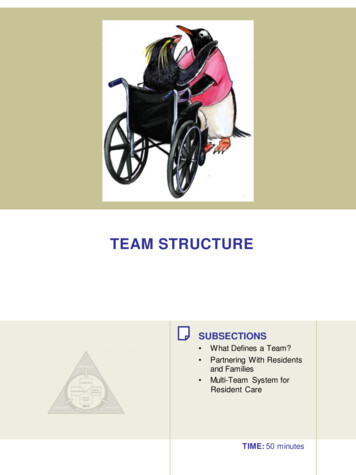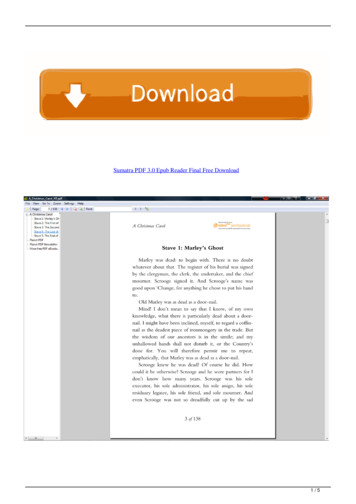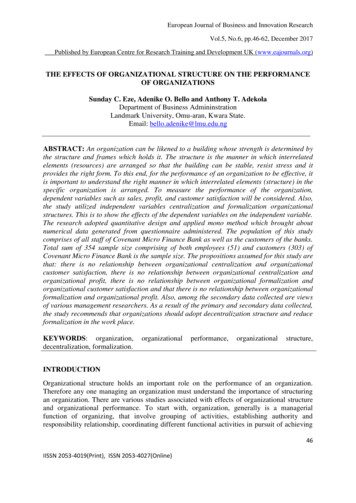
Transcription
TEAM STRUCTURESUBSECTIONS What Defines a Team?Partnering With Residentsand FamiliesMulti-Team System forResident CareTIME: 50 minutes
INSTRUCTOR OUTLINE: TEAM STRUCTUREInstructor Note: In this module, you will present informationabout the structure of teams. Although team structure does notaddress team competencies, it is important for participants to learnconcepts such as the inclusion of the resident as a member of theteam and the components of a multi-team system in terms ofplanning their TeamSTEPPS implementation.The Team Structure module includes the content provided in theoutline below. More content is available than can likely be coveredin the time provided; therefore, optional content and activities arenoted. It is strongly recommended that instruction not focus solelyon lecture, but also include exercises, videos, and other activities.As such, instructors should use the information below to plan howthe module will be taught within the time available.Content1.Introduction2.Definition of a TeamTeamStructureSlideMODULETIME:50 minutesMATERIALS: Teams andTeamworkExercise Sheet5-62 mins Flipchart orWhiteboard(Optional)72 mins Markers (Optional)Page #8Approx. Time5 – 10 mins*3.Teams and TeamworkExercise4.Partnering WithResidents and Families9 - 125 mins5.Multi-Team System13 - 1815 mins6.Team Structure Videoand Discussion19 - 2010 mins7.Applying TeamSTEPPSExercise215 mins TeamSTEPPSOpportunity LTCVideo (LTCOpportunityCompleteVignette.mpg) TeamSTEPPSImplementationWorksheet*Although all instructional content and activities are recommended toensure that participants achieve the learning objectives, theseactivities may be considered “optional” if time is constrained.B-2-3Continued TeamSTEPPS 2.0 for Long-Term Care Team StructureB-2-3
TeamStructureSlideINSTRUCTOR OUTLINE: TEAM STRUCTURE(Continued)Additional Resources: Below are sources of additionalinformation and videos you may want to use to customize thismodule to your participants. TeamSTEPPS 2.0: Includes teamwork success andteamwork failure videos in multiple hospital settings. tml TeamSTEPPS Rapid Response Systems Module (RRS):Videos in this module demonstrate how the Rapid ResponseTeam interacts and coordinates with other aspects of themulti- team system. 4TeamSTEPPS 2.0 for Long-Term Care Team Structure
OBJECTIVESTeamStructureSAY:Upon completion of this module, you will be able to: Discuss the benefits of team structure in teamwork; Define a “team”; Identify the role of residents and their families as part of thecare team; and Describe the components and composition of a multiteam system.TeamSTEPPS 2.0 for Long-Term Care Team StructureSlideB-2-5
TeamStructureTEAMSTEPPS TEAMWORK SKILLSSAY:SlideTeam structure refers to the composition of an individual team orof a multi-team system. Team structure is an integral part of theteamwork process. A properly structured care team is an enablerfor and the result of effective communication, leadership, situationmonitoring, and mutual support.Proper team structure can promote teamwork by including a clearleader, involving the resident, and ensuring that all team memberscommit to their roles in effective teamwork.It is important to identify and recognize the structure of teams,because teamwork cannot occur in the absence of a clearlydefined team. Further, understanding a team’s structure and howmultiple teams interact in a unit is critical for planning theimplementation of TeamSTEPPS tools and strategies. It is criticalto know which teams are targeted for TeamSTEPPS; who on theteam will adopt the TeamSTEPPS intervention; and how theintervention may affect other teams in the care environment.B-2-6TeamSTEPPS 2.0 for Long-Term Care Team Structure
WHAT DEFINES A TEAM?TeamStructureSAY:To effectively understand team structure, let’s begin with defininga “team.”A team is different from a group. A group can achieve its goalthrough independent individual contributions. Real-timecoordination of tasks between individuals is not required.SlideA team, however, consists of two or more people who interactdynamically, interdependently, and adaptively toward a commonand valued goal, have specific roles or functions, and have a timelimited membership. During the temporal life of a team, the team’smission is of greater value than the goals of the individualmembers.Team members: Include anyone involved in the process of resident care whocan take action, including the leader; Have clearly defined roles and responsibilities; Are accountable to the team for their actions; and Must stay continually informed for effective teamfunctioning.The teamwork skills you will learn in this course willprovide team members with tools and strategies for beingeffective team members.TeamSTEPPS 2.0 for Long-Term Care Team StructureB-2-7
TeamStructure(OPTIONAL) EXERCISE: TEAMS ANDTEAMWORKSAY:SlideLet's look at the team in your own work area. Please take a fewminutes to complete the Teams and Teamwork Exercise Sheet. Ifyou are sitting near your fellow team members, you may work onthis exercise together. If you are not sitting with your team, pleasecomplete it on your own. I’ll ask a few of you to share your workwith the rest of the class in a few minutes.TIME:DO:5-10 minutesGive the participants several minutes to complete their sheets.During the discussion, you may wish to document responses on aflipchart or whiteboard.MATERIALS: Teams andTeamworkExercise Sheet Flipchart orWhiteboard(Optional) Markers(Optional)B-2-8DISCUSSION: Who are the team members in your unit, department or workarea? How many of you included residents in your list of teammembers? What characteristics make a group a team?TeamSTEPPS 2.0 for Long-Term Care Team Structure
TeamStructurePARTNERING WITH THE RESIDENTSAY:It is critical to acknowledge that a care team is not completewithout the resident. Residents and their families should beembraced and valued as contributing partners to care.Throughout this course, you will learn several teamwork skills,tools, and strategies that can easily be adapted for use byresidents and their families. Thinking about how to includeresidents is an important part of your TeamSTEPPSimplementation planning.SlideExamples of effective strategies for involving residents in theircare include: Including the resident in care planning; Conducting handoffs at the resident’s bedside; Providing residents with tools for communicating with their careteam; Involving residents in key committees; and Actively enlisting the resident’s participation.A number of organizations provide information, materials, andsuggested strategies related to patient and residentengagement, including AHRQ, the DoD Patient Safety Program,the Joint Commission, the National Patient Safety Foundation(NPSF), the U.S. Department of Health and Human Services(DHHS), the Institute for Healthcare Improvement (IHI), andConsumers Advancing Patient Safety (CAPS).Example resources: The AHRQ-funded Guide to Patient and Family Engagement:Environmental Scan mental-scan-report The DoD Patient Safety Program’s Team nd-Services/TEAM-UPContinued TeamSTEPPS 2.0 for Long-Term Care Team StructureB-2-9
TeamStructureSlidePARTNERING WITH THE RESIDENT (Continued)Example resources (Continued): DoD Patient Activation Reference ce-Guide The Joint Commission’s Speak Up:https://www.jointcommission.org/speakup.aspx NPSF’s Ask Me 3:http://www.npsf.org/?page askme3 DHHS’ Partnering to -heal.asp IHI’s Person- and Family-Centered Care efault.aspx Information from ces.htmlB-2-10TeamSTEPPS 2.0 for Long-Term Care Team Structure
CARE TEAM RESPONSIBLITIESTeamStructureSAY:Working with residents and families as true partners includes: Listening to residents and their families. Asking residents how involved they prefer to be in theirown care. Before launching into detailed status, asking residents abouttheir concerns; otherwise, they might not listen to orunderstand what is being said to them. Speaking in terms they understand to ensure thatresidents and families understand the informationbeing shared. Allowing time for residents and families to ask questions. Providing residents and families access to relevant information. Asking residents and their families for feedback and to beproactive participants in resident care—they are alsoresponsible for transforming relationships between health careproviders and residents.TeamSTEPPS 2.0 for Long-Term Care Team StructureSlideB-2-11
TeamStructureRESIDENT AND FAMILY RESPONSIBLITIESSAY:The responsibilities of residents and their families as part of theteam differ from those of the care team members. Resident andfamily responsibilities include:Slide Providing accurate resident information. Complying with the prescribed plan of care. Forexample, residents and families are responsible forscheduling and attending appointments as directed. Asking questions and/or voicing any concerns regardingthe care plan. Monitoring and reporting any changes in the resident’scondition in a timely manner. Managing family members to prevent disruptive behaviorduring care. Following the instructions of the care team.DISCUSSION:B-2-12 Have you implemented any specific strategies for engagingresidents and their families in your unit, department, or workarea? If so, what has worked well and what has not worked well? What changes have you seen as a result of engagingresidents in their care?TeamSTEPPS 2.0 for Long-Term Care Team Structure
MULTI-TEAM SYSTEM FOR RESIDENT CARETeamStructureSAY:We have discussed what defines a team, but in health care,multiple teams are involved in resident care. This slide shows themodel of a multi-team system. Each team within a multi-teamsystem is responsible for various parts of resident care, but allmust act in concert to ensure quality care.SlideA multi-team system is composed of several different teams. Themulti-team system includes the Core Team, the ContingencyTeam, the Coordinating Team, Ancillary and Support Services,and Administration. In addition, it is important to acknowledge theresident as a critical part of the multi-team system.As we discuss each of the components of the multi-team system,think about whether each team should be included in yourTeamSTEPPS implementation plan.TeamSTEPPS 2.0 for Long-Term Care Team StructureB-2-13
TeamStructureCORE TEAMSSAY:SlideCore Teams consist of team leaders and team members who areinvolved in the direct care of the resident. Core Team membersinclude direct care providers and continuity providers. Continuityproviders manage the resident from assessment to disposition,such as case managers. The Core Team is based where theresident receives care.Core Teams should be small enough to ensure situationmonitoring, development of situation awareness, and direct,unfiltered communication between members. To establish ashared mental model, Core Teams should be large enough toinclude skill overlap between members to allow for workloadsharing and redistribution when necessary. Every Core Team hasa leader who is readily identified by all members of the team.Core Team leadership is dynamic; Core Team leaders arerequired to take on different roles at various points in the plan ofcare. Often these may be nonleadership roles, such assupporting a nurse starting an IV.Examples of Core Teams include:Dementia Unit: The Core Team may be composed of the attending physician,physician assistant (PA), advanced practice registered nurse(APRN), nurse, nursing assistants, and restorative aidesresponsible for treating a resident.Subacute Unit: B-2-14The Core Team may be composed of the physician, nurse, andrehabilitation staff responsible for cardiac rehabilitation of aresident.TeamSTEPPS 2.0 for Long-Term Care Team Structure
CONTINGENCY TEAMSTeamStructureSAY:Contingency Teams are: Formed for emergent or specific events;Time limited (e.g., Code Team, Disaster Response Team,Rapid Response Team*); andComposed of team members drawn from a variety of CoreTeams.Slide*A TeamSTEPPS Rapid Response Systems Guide is availablefrom AHRQ. For more information, go Contingency Teams are responsible for immediate, directresident care during emergency situations requiring moreresources than are available to the Core Team. In the nursinghome, this may be referred to as “all hands on deck.” Their rolemay be very specific and limited to a certain situation, such as aCode Team, or they may be responsible for a broad category ofsituations, such as disaster response. They generally consist ofpreidentified members derived from varying units, work areas, orCore Teams and have limited time to prepare for emergencies.Because Contingency Team members are called together foremergent or specific events, they do not typically spend muchtime working together as a team. However, their individual rolesare clearly defined, and leadership is designated based onresident needs and member expertise in dealing with theparticular situation.Examples of Contingency Teams include:Dementia Unit: The Contingency Team may composed of the care planningteam, emergent “code” teams, and hospice/palliative careteams, or a consulting pharmacist who can be called upon toparticipate if the medication regimen is complicated andrequires special pharmacological expertise.Subacute Unit: The Contingency Team may compose of the MDS Coordinatorsand the care planning team.TeamSTEPPS 2.0 for Long-Term Care Team StructureB-2-15
TeamStructureCOORDINATING TEAMSSAY:The Coordinating Team is the group responsible for: Day-to-day operational management; Coordination functions, such as triaging emerging eventsand prioritizing decisionmaking to ensure maximal support tothe Core Team; and Resource management for Core Teams, such ascollaborating with the Administrative and Ancillary Teams toassign priorities and ensure throughput.SlideDirect resident care may be a secondary function withthe exception of small facilities.Coordinating Teams frequently include experienced personnelwith a strong clinical background. This combination enhances theability of the Coordinating Team members to rapidly assess theoverall picture, anticipate the needs or potential needs betweenand across teams, and make priority-based decisions.ASK: Who might be the members of the Coordinating Team on adementia unit?– Nurse supervisors, department heads, and unit managers orunit secretaries who may be responsible for resourcemanagement and promotion of teamwork for the unit Who might be the members of the Coordinating Team on asubacute unit?– The unit charge nurse or the director of nursing responsiblefor admissions and resource management for the cardiacrehabilitation or subacute unitsB-2-16TeamSTEPPS 2.0 for Long-Term Care Team Structure
ANCILLARY AND SUPPORT SERVICESTeamStructureSAY:Ancillary Services consist of individuals who: Provide direct, task-specific, time-limited care to residents; Support services that facilitate care of the residents; and Are often not located where the residents receive theirroutine care.SlideAncillary Services are primarily a service delivery team whosemission is to support the Core Team. In general, an AncillaryServices Team functions independently.Support Services are primarily a service-focused team whosemission is to create efficient, safe, comfortable and cleanhealth care environments, which affect the resident care team,market perception, operational efficiency, and resident safety.ASK: What are some examples of Ancillary and SupportServices teams?Possible Answers: Ancillary services– Laboratory– X-ray– Pharmacy– Recreation– Social Services– Rehabilitation/Occupational Therapy– Dietary Support services– Housekeeping– Supply– Human Resources– Laundry– Physical Plant– Staff Development/Staff EducationTeamSTEPPS 2.0 for Long-Term Care Team StructureB-2-17
TeamStructureTHE ROLE OF ADMINISTRATIONSAY:SlideAdministration includes the executive leadership of a unit or facilityand has 24-hour accountability for the overall function andmanagement of the nursing home. The Administrative Team hasno responsibility in the direct delivery of care but provides theframework and guidance that ensure that each team understandsits role and responsibility and has access to the necessaryresources to succeed.Administration creates the climate and culture for a teamworksystem to flourish by: Establishing and communicating vision; Developing and enforcing policies and procedures thatclearly articulate the roles and responsibilities of the otherteams and team members; Setting expectations for staff; Providing necessary resources for successful implementation; Holding teams accountable for team performance; and Defining the culture of the nursing home.Administration should strive to create a learning culture wherethere is trust and transparency to create a safe environment toreport, analyze, and share information openly. This philosophyserves to define a culture of safety; however, as examples inaviation and other high-risk industries have shown, the changewill not happen overnight.B-2-18TeamSTEPPS 2.0 for Long-Term Care Team Structure
TEAM STRUCTURE VIDEOTeamStructureSAY:Please consider how the lack of team structure plays a role in thesituation shown in this video. Please note that the job titles of “nursemanager” and “nurse supervisor,” which are used in this video, aremore common in a hospital setting.DO:Play the video by clicking the director icon on the slide.SlideVIDEO TIME:3:15 minutesDISCUSSION: Go to next page MATERIALS: TeamSTEPPSOpportunity LTCVideo (LTCOpportunityCompleteVignette.mpg)TeamSTEPPS 2.0 for Long-Term Care Team StructureB-B-2-19
TeamStructureTEAM STRUCTURE VIDEO ANALYSISSAY:Now let’s discuss what you saw in the video vignette.DISCUSSION:Slide What members of each of the following teams were involvedin this scenario?– The Core Team?– The nursing assistants (Lucy and Carmen).– The attending physician (Dr. Flores).– The nurse manager (Gayle).– The Coordinating Team?– The nurse supervisor (Liz).– The Contingency Team?– No members of this team appeared in the video.– Ancillary and Support Services?– The social worker (Christine).– The recreation therapist (Jennifer). Where did the breakdowns occur between the componentsof this multi-team system?– The nurse manager asked the team to “keep an eye” on Mrs.Smith, but did not assign a specific task to a specific teammember.– The social worker did not effectively communicate herobservations and concerns to the nursing assistants, andthe nursing assistants were not receptive to the socialworker’s input.– The physician was never alerted to the changes in Mrs.Smith’s behavior until after she had fallen. When the nursesupervisor did call the physician, she did not effectivelycommunicate Mrs. Smith’s condition, and he seemedunwilling to address the concerns. B-2-20What could the individuals involved in this scenario have donedifferently to produce a better outcome?TeamSTEPPS 2.0 for Long-Term Care Team Structure
EXERCISE: APPLYING TEAMSTEPPSTeamStructureInstructor Note: This slide is intended for the MasterTraining course only. The previous slide should be the last oneshown to staff participants at your nursing home.SAY:Now return to your TeamSTEPPS Implementation Worksheet.After the Introduction module, you identified the teamwork issue orissues that you plan to address with TeamSTEPPS. Now, thinkabout the area in which you intend to use TeamSTEPPS toimprove performance.Think about: What types of team members make up each team? How do the teams in your unit, department, or work area interactwith one another? How might each of the teams fit into your TeamSTEPPSimplementation plan?SlideMATERIALS: TeamSTEPPSImplementationWorksheetDO:Ask a few individuals to report on the multi-team system that willbe affected by their intended TeamSTEPPS implementation.TeamSTEPPS 2.0 for Long-Term Care Team StructureB-2-21
Team Structure . TEAMSTEPPS TEAMWORK SKILLS. Slide. SAY: Team structure refers to the composition of an individual team or of a multi-team system. Team structure is an integral part of the teamwork process. A properly structured care team is an enabler for and the result of effective communication, leadership, situation monitoring, and mutual .










